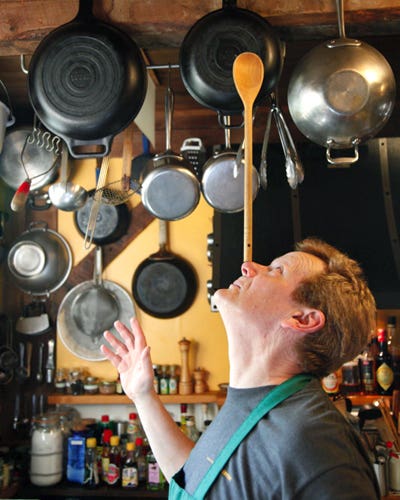
Balancing Act: High-Wire Artist Philippe Petit’s Catskills Kitchen
Of course high-wire walker Philippe Petit would christen his home Cable House. In 1974, at the age of 24, Petit famously (and illegally) walked a tightrope stretched between the twin towers of the World Trade Center, a heart-stopping 1,350 feet above the ground. Petit, now 61, still stages tightrope walks, and his trade is very much in evidence at his home in the Catskills. To the left of the front porch, suspended several feet off the ground, there is the galvanized-steel cable, just under an inch in diameter, on which Petit practices daily. Nearby is the small barn where there's another wire (for tightrope walking in bad weather) and a small stage where he practices juggling for the street performances, lectures, teaching gigs, and high-wire performances that take him all over world. But it's in a room directly inside the front door of the main house that Petit performs some of his most daring feats: the kitchen.
A 170-square-foot boxy room with bright yellow walls, the kitchen bears the imprimatur of both Petit and Kathy O'Donnell, his partner in work and life (and the occasional crime for art's sake). The two bought the house in 1992, at first as a getaway from life in New York City. Constructed by the previous owners from parts of a barn that once stood elsewhere on the property, the house has an improvised feeling that's just right for this couple.
Over the years, Petit and O'Donnell began to spend more time at Cable House, gradually making it their primary residence. They continued to transform the space with a resourcefulness and a knack for living splendidly on very little that has served them well ever since Petit's pass-the-hat days back in Paris in the late 1960s. In the kitchen, they replaced the decor they'd inherited with a mix of elements found on the property, collected on their travels, and given to them by friends. The cabinets are covered with the thick industrial yellow paint used to lay down stripes on asphalt roads—a contribution from sculptor John Kahn, who also nabbed the couple the square of granite, a tile store sample, that's set into the center island. Petit and O'Donnell tore out the old pink melamine countertops and replaced them with white Carrara marble donated by the Reverend James Parks Morton, dean emeritus of the Cathedral of St. John the Divine, where Petit has been an artist-in-residence since 1982.
Everywhere, too, are signs of Petit's genius for on-the-fly engineering. The stove, a 1953 propane-fueled Magic Chef, has chronic problems: the V-shaped inserts that regulate the flow of gas to the burners keep breaking, so Petit fashions new ones out of scrap metal; an old film canister functions as a case for a nutmeg grater; on a shelf, there's a homemade eggbeater that Petit devised, in which a wooden fork rotated by a leather cord agitates the contents of a glass.
But it's when Petit cooks that his artistry makes itself most fully felt in the kitchen. Although Petit has always loved to eat, for most of his life he had no idea how to cook. A few years ago, wanting to honor O'Donnell, who has cooked for both of them for decades, Petit decided to learn. "I love the challenge," he says. Once a week, as his schedule allows, Petit prepares an elaborate themed dinner. One evening, he cooks a meal from Chanterelle, a favorite (though recently shuttered) New York City restaurant. After selecting recipes (deviled quail eggs with caviar, pork chops, and slow-roasted pears), he transposes each into rebuslike notes in which he diagrams each step of the meal, calculating sequence and timing with obsessive precision. As he works, he refers often to his notebook, where meticulously annotated sketches help him make the distinction between, say, flat-leaf parsley and cilantro. "I apply my nature as a wire walker," he says. "Every detail is important." Even so, something usually goes slightly awry—the crotchety stove doesn't behave quite as intended, or the recipe instructions were too vague or confusing. "I like to complain that there is no cookbook that tells you exactly what to do," Petit says. "But actually, in the end, the teacher who tells you exactly how to put your foot on the wire is a bad teacher. You have to figure it out for yourself."
_
Rebecca Saletan is the editorial director of Riverhead Books. This is her first article
for Saveur._
Keep Reading
Continue to Next Story










